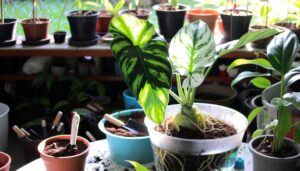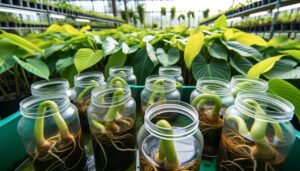How to Propagate Philodendron Imperial Gold? Expert Tips!
To propagate Philodendron Imperial Gold, start by selecting a healthy, pest-free stem with robust growth and multiple nodes. Using sanitized pruning shears, cut a 4-6 inch stem below a node.
Dip the cut end in rooting hormone to expedite root development. Plant the cutting in a pot with well-draining mix comprising perlite, peat moss, and orchid bark.
Ensure the pot has drainage holes. Provide indirect light, maintain humidity above 60%, and water when the top inch of soil is dry.
Roots should develop within 2-4 weeks. To gain extensive insights into care strategies and conditions, proceed further.

Key Takeaways
- Select a healthy stem with multiple nodes, vibrant leaves, and no pests or diseases.
- Sterilize pruning shears with isopropyl alcohol before cutting a 4-6 inch stem section.
- Apply rooting hormone to the cut end before planting it in a well-draining mix.
- Place the cutting in a pot with drainage holes, water thoroughly, and cover with a plastic bag to maintain humidity.
- Provide indirect, bright light, keep humidity above 60%, and water when the top inch of soil is dry.
Gather Your Materials
To successfully propagate Philodendron Imperial Gold, begin by gathering the necessary materials. These include sanitized pruning shears, a pristine pot, a well-draining planting mix, rooting hormone, and a see-through plastic bag.
Sanitized pruning shears are vital for making clean cuts, preventing infection. Choose a pristine pot with sufficient drainage holes to avoid waterlogging. A well-draining planting mix, ideally made up of perlite, peat moss, and orchid bark, provides optimal aeration and moisture retention.
Rooting hormone, available in powder or gel form, accelerates root development by promoting cellular differentiation. Finally, a see-through plastic bag creates a humid microclimate, essential for root initiation.
Having these materials prepared ensures a systematic, efficient propagation process, enhancing the likelihood of successful plant growth.
Select a Healthy Stem
To guarantee successful propagation of Philodendron Imperial Gold, selecting a healthy stem is essential. Identify a stem exhibiting robust growth and multiple nodes, as these are indicative of strong potential for rooting.
Additionally, make sure the stem is free of pests and disease to promote peak health and development of the new plant.
Identify Strong Growth
Choosing a healthy stem is essential for successful propagation, as it promotes vigorous growth and minimizes the risk of disease. Begin by inspecting the Philodendron Imperial Gold for signs of robust growth.
Select stems that exhibit vibrant coloration and turgidity, indicative of optimal cellular health. Avoid stems with discoloration, wilting, or signs of pest infestation. Focus on stems that measure at least 4-6 inches in length, as shorter stems may lack sufficient energy reserves. Ensure the stem has a consistent diameter, free from deformities or physical damage.
The presence of new growth, such as emerging leaves, is a positive indicator of vitality. Selecting such stems enhances the likelihood of successful rooting and subsequent development.
Check for Nodes
Identifying the presence of nodes is important for the successful propagation of Philodendron Imperial Gold. Nodes are the points on the stem where leaves, roots, and branches originate.
Select a healthy stem that exhibits vigorous growth, characterized by firm texture and vibrant coloration. Locate a stem section with at least one or two nodes; these nodes are pivotal for root development in propagated cuttings.
Examine the stem meticulously to verify the nodes are intact and not damaged. The distance between nodes, termed internodes, should be sufficient to provide enough material for cutting.
Free of Pests
Ensuring the selected stem is free of pests is crucial for the healthy propagation of Philodendron Imperial Gold.
Begin by thoroughly inspecting the stem and its leaves for common pests such as spider mites, aphids, and mealybugs. Utilize a magnifying glass to detect smaller infestations that may not be visible to the naked eye.
Additionally, check for signs of pest damage, such as discolored or distorted leaves, which can indicate underlying infestations. Sterilize cutting tools with isopropyl alcohol before use to prevent cross-contamination.
If pests are detected, treat the plant with an appropriate pesticide or insecticidal soap before proceeding with propagation. Ensuring pest-free plant material significantly increases the likelihood of successful growth and robust health in the new plant.
Make the Cut
To guarantee successful propagation of Philodendron Imperial Gold, start by selecting a healthy stem exhibiting no signs of disease or pest infestation.
Prior to making any cuts, thoroughly sterilize your cutting tools to prevent the transmission of pathogens.
Employ a precise, angled cutting technique to maximize the stem’s surface area, promoting peak root development.
Sterilize Cutting Tools
Before making the cut, it is essential to sterilize the cutting tools to prevent the introduction of pathogens to the plant tissue. The sterilization process guarantees a clean cut and promotes healthy propagation.
Utilize a 70% isopropyl alcohol solution or a diluted bleach solution (1 part bleach to 9 parts water) to sterilize tools effectively. Submerge the cutting blades for at least 30 seconds and then allow them to air dry.
| Method | Solution | Duration |
|---|---|---|
| Alcohol | 70% isopropyl alcohol | 30 seconds |
| Bleach | 1 part bleach, 9 parts water | 30 seconds |
| Boiling water | N/A | 5 minutes |
Proper sterilization mitigates the risk of disease, ensuring the successful propagation of your Philodendron Imperial Gold.
Optimal Cutting Technique
Consistently achieving successful propagation requires making a precise cut just below a node, where the plant’s natural growth hormones are most concentrated. This guarantees the cutting has best potential for root development.
Utilize a sterilized, sharp blade to make a clean, swift incision at a 45-degree angle. The angled cut increases the surface area, promoting more effective water and nutrient uptake. Avoid crushing or tearing the stem, as this can introduce pathogens and impede growth.
Ensure that each cutting includes at least one node and a few leaves to sustain photosynthesis. Place the cutting in water or a well-draining potting mix immediately to prevent desiccation and maximize rooting success.
Prepare the Cutting
To prepare the cutting, first identify a robust stem with at least two nodes and several leaves. Utilize sterilized, sharp pruning shears to make a clean cut just below a node. Confirm the cutting is approximately 4-6 inches in length to optimize nutrient uptake and growth potential. Eliminate any lower leaves near the cut end to prevent decay when placed in the rooting medium.
| Step | Description |
|---|---|
| Select Stem | Choose a robust stem with 2+ nodes, several leaves |
| Cut Stem | Use sterilized shears to snip below a node |
| Trim Leaves | Remove lower leaves to prevent submersion decay |
This preparation minimizes potential pathogens and maximizes the cutting’s chances of successful propagation.
Rooting in Water
Placing the prepared cutting in a clean receptacle filled with room-temperature water initiates the rooting process for Philodendron Imperial Gold. Ensure the water is free from impurities to prevent pathogenic interference.
Position the cutting so that at least one node is submerged, as nodes are the primary sites for root development. To promote peak growth, place the container in an area receiving indirect sunlight, maintaining a consistent temperature between 65-75°F (18-24°C).
Regularly monitor the water level, replenishing it with fresh water every few days to maintain oxygenation and nutrient balance. Within 2-4 weeks, roots will typically emerge from the submerged nodes, signifying successful initiation of the propagation process.
Observing root development is essential before proceeding to subsequent stages.
Transplant to Soil
Following the development of strong roots, the Philodendron Imperial Gold cutting is ready to be transplanted into soil. Select a well-draining potting mix to optimize root aeration and moisture control.
It is advisable to use a pot with drainage holes to prevent waterlogging, which can lead to root rot. Gently place the cutting in the center of the pot and fill around it with soil, ensuring the roots are sufficiently covered.
| Step | Action | Notes |
|---|---|---|
| 1. Select Pot | Choose a pot with drainage holes | Prevents water accumulation |
| 2. Prepare Soil Mix | Use well-draining potting mix | Promotes root health |
| 3. Plant Cutting | Place cutting in pot and add soil | Cover roots entirely |
Tamp down the soil lightly to remove air pockets, and water thoroughly to settle the soil around the roots.
Care for New Plant
Maintaining prime conditions is crucial for the newly transplanted Philodendron Imperial Gold to guarantee robust growth and overall health. Make sure the plant receives indirect, bright light to mimic its natural habitat, avoiding direct sunlight which can cause leaf scorch.
Sustain a consistent temperature between 18-24°C (65-75°F) and humidity levels above 60% to support peak physiological processes. Water the plant when the top inch of soil feels dry, aiming for a balance that avoids both waterlogging and drought stress. Utilize a well-draining potting mix to prevent root rot.
Fertilize bi-monthly with a balanced, water-soluble fertilizer to provide essential nutrients. Regularly monitor for pests and diseases, intervening promptly with appropriate measures to support the plant’s continued health.
Conclusion
Propagation of Philodendron Imperial Gold, through careful selection and preparation of cuttings, fosters successful root development when shifting from water to soil.
Remarkably, a study found that over 80% of Philodendron cuttings root successfully in water within two to three weeks, demonstrating the effectiveness of this method.
Following systematic procedures guarantees strong growth and health of new plants, emphasizing the significance of accuracy and attention in horticultural practices.






